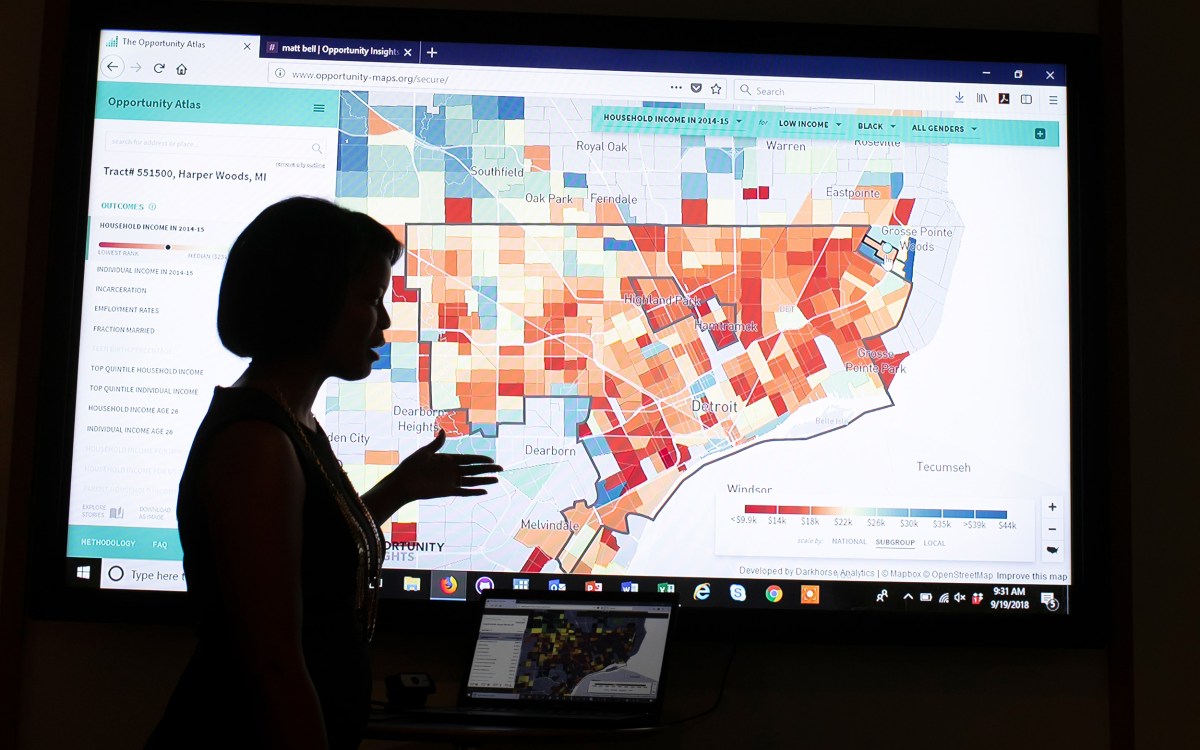
Associate professor of sociology Ellis Monk weighs in on potential flaws in the U.S. census.
Rose Lincoln/Harvard file photo
2020 census racial data lacks nuance, sociology professor says
Ellis Monk says wording of questions, presentation, various changes probably affected count
A quick scan of the headlines generated by the recently released 2020 census data will tell you that the white population is in steep decline and that minority groups are on the rise. But associate professor of sociology Ellis Monk says there’s more to the population count than what is being reported by the media.
Monk’s research interests include issues around social inequality and political sociology, and some of his recent work involves understanding colorism and the role skin tone stratification plays in inequities. The media obsessed over census findings suggesting a shrinking of the portion of the population that is white, but Monk believes the issue of race and how it is quantified is much more complex than the way it’s being characterized.
“One takeaway that we saw in the media a lot was about the alleged decline of the white population and certain rises in the ‘mark one or more’ [races] multiracial or biracial population,” he said. “My main reaction is really to the way that the questions, the forms on the census itself are actually produced” because much depends on how they are worded and presented.
Research has shown that how questions are framed can have a profound effect on results, he said. And some of the questions regarding race and ethnicity were reconfigured for 2020.
Census data revealed that the population of people who chose “white” as their sole racial group declined by 8.6 percent since 2010, the last census. Meanwhile, the multiracial population saw an explosion in reporting, jumping 276 percent from 9 million people in 2010 to 33.8 million in 2020.
Some demographic changes can be attributed to wording choices, Monk said. The census has been collecting data regarding race and ethnicity since 1790, but the latest population count changed the ways individuals could self-identify. Previous censuses asked only Hispanic respondents to include their origin. The 2020 census for the first time expanded origin questions to all respondents. It also called for Latinx people to identify as “of Hispanic, Latino, or Spanish origin,” and in addition to identify their race.
Problems involving race and ethnicity in the census are longstanding. The bureau estimates that in 2010 it overcounted whites and undercounted Black and Latinx people and Native Americans who live on reservations.
Accuracy in the count is important because the data is used to determine the number of seats each state gets in the U.S. House of Representatives and to redraw electoral districts. In addition, the numbers are used to determine how much federal funding communities get for schools, hospitals, roads and public works.
Census officials began looking into possible changes to questions regarding race in 2015. That year, Monk participated in a panel with bureau researchers at the American Sociological Association who were running tests for an “alternative question” experiment. The experiment involved different ways of asking questions about people’s origins, particularly those from the Middle East and Latin America. Researchers found that racial or ethnic results changed drastically depending on how self-identification questions were asked.
Besides changes in language, the way questions were spaced or worded “certainly could have played into the rise of the number of people who feel compelled to mark one or more categories on the census,” Monk said.
“My first response there is that the presumption underlying there is that there’s an objective truth about someone’s racial identity.”
Ellis Monk
The sociologist also pushed back on speculation by demographers that some part of the decline among the white population may have been due to uncertainty among some Latinx respondents about how to answer the race question. He said that assuming people are unsure about how to answer a race question implies that there’s a right answer.
“My first response there is that the presumption underlying there is that there’s an objective truth about someone’s racial identity,” he said. “That makes me somewhat uncomfortable in kind of thinking that people may feel unsure about how to answer a question.”
Monk acknowledged that the numbers do support the report that there are fewer people who identified as both Hispanic and white in 2020 than there were in 2010.
“That might be a function of the political context that we’re in and increasing recognition of xenophobia, anti-Latino, [and] anti-Hispanic discrimination in the Trump era,” Monk said, adding that the political atmosphere may have made people rethink how they self-identify or skip responding altogether.
The information collected during the population count is important to give us a broad understanding of the levels of ethno-racial inequality in our society, Monk said. However, he noted that the categories used by the census fail to account for how people appear, including their skin tone, facial features, and hair type, all of which are used when people discriminate against others.
“One thing that we know — from my own research and other people who do this research on colorism and skin tone stratification — is that there’s quite significant inequality associated with differences in skin tone,” he said. For example, research shows that there is more education inequality within the Black population along the skin tone continuum from light to dark than there is between Black and white people as a whole.
That lack of nuance in the census data collection limits what we can truly learn about racial inequality in the country, Monk added.
“One of the major concerns going forward is really how certain elements that we’re seeing in society right now, people talking — particularly more [among] the right-wing conservatives in the political spectrum — are about things like the replacement thesis, this idea that somehow white people are going to end up being the minority in the country.” Monk said he is already seeing the data being used that way among increasingly vocal groups of white supremacists.
The 2020 census faced a number of additional hurdles, including funding problems, various practical and logistical complications brought about by COVID-19, and controversy over an unsuccessful bid by the Trump administration to add a citizenship question.
“I think even pre-pandemic, you have these kinds of factors about the political context, a general perception that there was a lack of resources given to the census to even conduct the census in the first place,” Monk said. “You add in the pandemic, and, certainly, I would actually say that I would be surprised if there was not an undercount.”
The potential undercount of Black and brown people in the U.S. will ultimately affect the kinds of resources and representation those communities are able to receive, Monk said.







